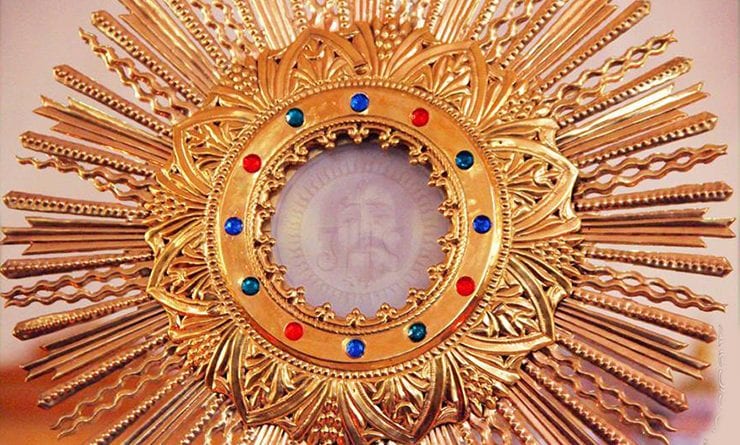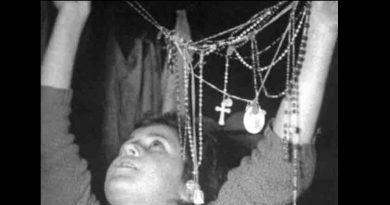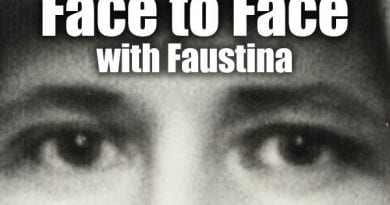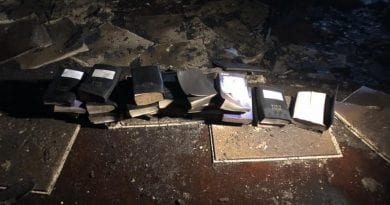There are 22 Eucharistic miracles in Italy.The powerful sign of God on our ‘distracted’ nation.
St. Anthony and the Mule in Rimini, the fool foiled, the fire saved. The wonders of the body of Christ.
From north to south, along the entire peninsula, as highlighted by Avvenire (19 September) , important Eucharistic miracles occurred. So we have drawn a detailed map, from Veneto to Puglia, of all the extraordinary events that have happened up to today.
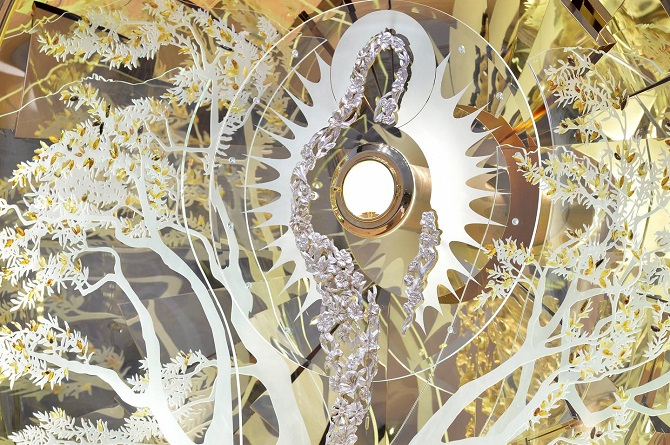
1) GRUARO (VENICE), 1294
A woman was washing one of the altar cloths of the church of San Giusto on the washhouse built along the Versiola canal. Suddenly she saw the linen of the altar cloth tinged with blood. Looking more closely, she noticed that the blood was coming out of a consecrated particle that had remained in the folds of the altar cloth.
The most authoritative and ancient document describing the Miracle is a 1454 transcript of Pope Nicholas V. It was then that the title of the parish church, formerly Santa Maria and San Giovanni Evangelista, was changed, by the disposition of Pope Nicholas V, to the Church of the Most Holy Body of Christ (March 28, 1454). Today the altar cloth is kept in a crystal cylinder, supported by a silver reliquary made by the goldsmith Antonio Calligari .
2) TURIN, 1453
In the Alta Val Susa near Exilles, the troops of Renato d’Angiò clashed with the militia of the Duke Lodovico di Savoia . Here the soldiers abandoned themselves to the looting of the village and some entered the church. One of them forced the little door of the tabernacle opened and stole the monstrance with the consecrated Host. He wrapped up all the stolen goods in a sack onto the back of a mule headed for Turin. On the main square, near the Church of the Holy Spirit (known today as the Church of Corpus Domini) the mule stumbled and fell. The sack opened and the monstrance with the consecrated Host began to rise above the surrounding houses, amid people’s amazement.
The bishop also came, who with the crowd, marveled at the miracle. He had a cup in his hand, raised it upward and slowly the consecrated Host began to descend, placing Itself in the cup.
The earliest documents describing the miracle are the Chapter Acts of 1454, 1455, 1456 and some writings of the City of Turin.
.
3) CANOSIO (CUNEO), 1630
Don Antonio Reinardi , a parish priest of Canosio, a small village in the diocese of Saluzzo along the banks of the Maira creek, called all the citizens with the sound of the bells to invite them to pray to the Lord to stop its flooding. He also proposed to make a vow: if the village of Canosio would be spared from the devastating fury of the Maira, the citizens would have a perpetual celebration of a festival every year on the octave of Corpus Domini. Don Rainardi took the Blessed Sacrament which he placed in the monstrance and went in procession towards the creek, accompanied by some faithful, singing the “Miserere”.
The blessing gave way, the rain stopped immediately and the creek’s level returned immediately to normal. Unfortunately, many of the documents describing the Miracle, preserved until the seventeenth century in the parish archives, were burned during the war between Spain and France; however, there is a copy of the report left by the parish priest who was a direct witness to the events.
4) DRONERO (CUNEO), 1631
On Sunday, August 3, 1631, around the time of Vespers, a great fire broke out in the town of Dronero, in the Marquisate of Saluzzo. The population tried in every way to tame the fire, but every attempt proved vain. The fire meanwhile increased more and more. Father Maurizio da Ceva , Capuchin, had the inspiration to resort to the power of the veiled Savior under the Eucharistic species. Immediately he organized a solemn procession with the Blessed Sacrament and followed by all the citizens, he went to the place of the fire. At dawn, before the Blessed Sacrament, the fire miraculously stopped.
A plaque in the church of Santa Brigida a Dronero describes in detail the Miracle and every year, on the occasion of the feast of Corpus Domini, the citizens of Dronero honor the memory of the Miracle with a solemn procession with the Blessed Sacrament.
5) FERRARA, 1171
This Eucharistic Miracle took place in Ferrara, in the Basilica of Santa Maria in Vado, on Easter Sunday. Father Pietro da Verona , prior of the Basilica, was celebrating the Mass of Resurrection and at the consecration, while he broke the Host, saw from this spurt a stream of blood that went with its droplets to stain the small vault over the altar of the celebration. The blood-stained small vault was later enclosed in a small temple built in 1595, and is still visible today in the monumental Basilica of S. Maria in Vado.
There are numerous testimonies that mention the Miracle, among these the most important is the Bull of Pope Eugene IV(March 30, 1442), in which the Pope mentions the Miracle referring to the testimonies of the faithful and the ancient historical sources. The manuscript of Gerardo Cambrense is the oldest document (1197) that mentions the Miracle and is kept in the Lamberthian Library of Canterbury.
.
.
6) RIMINI, 1223
In his intense activity of evangelization, St. Anthony was active in Rimini around 1223 and it is precisely in this period that the miracle is attested by numerous historical books. The Eucharistic Miracle occurred with St. Anthony after a certain Bonovillo, a heretic, challenged him to demonstrate with a miracle the true presence of the Body of Christ in communion.
The appointment between the two was set in Piazza Grande (the current Piazza Tre Martiri), before an immense crowd of onlookers. The saint held between his hands the consecrated Host, contained in a monstrance; the heretic held his hungry mule. The saint, after having requested and obtained silence, turned to the mule with these words: “In virtue and in the name of your
Creator, Who I, as unworthy as I am, hold in my hands, I tell and order you: Come forward immediately and render homage to the Lord with all due respect so that heretics and evildoers will understand that all creatures must humble themselves before their Creator whom priests hold in their hands at the altar.” And immediately the animal, refusing the food offered by its master, docilely approached the priest. It bent its front legs before the Host and paused there reverently. In memory of this miracle, a small church dedicated to St. Anthony with a small temple in front of Bramante (1518) was built in Piazza Tre Martiri.
7) BAGNO DI ROMAGNA, 1412
In 1412, the then prior of the Basilica of Santa Maria di Bagno di Romagna, Father Lazzaro of Verona, while celebrating Holy Mass, was assailed by strong doubts about the real presence of Jesus in the SS. Sacrament. He had just pronounced the words of the consecration of wine and it turned into living blood and began to boil leaking from the glass and pouring over the body. Father Lazzaro , deeply moved and repentant, confessed to the faithful present at the celebration his incredulity and the amazing Miracle that the Lord had worked under his gaze.
In 1912 Cardinal Giulio Boschi , Archbishop of Ferrara, celebrated the fifth centenary of the Miracle, followed by a conference of Eucharistic studies.
.
.
8) FLORENCE, 1292 and 1595
In the church of Sant’Ambrogio in Florence, there are the relics of two Eucharistic prodigies that took place in 1230 and 1595. In the Miracle of 1230, a priest left a few drops of consecrated wine in the chalice. The following day, coming back to celebrate Mass in the same church, he found drops of living, raw and incarnated blood inside the chalice. The blood was immediately collected in a crystal ampoule. The Bishop Ardingo of Pavia ordered them to bring the Relic to the Bishopric, and after a few weeks he placed it with the Sisters of the Monastery who guarded it at the church of Sant’Ambrogio.
The other Eucharistic Miracle occurred on Good Friday of the year 1595, when, after a raging fire broke out in the church, some consecrated Particles remained miraculously intact. In 1628 the Archbishop of Florence, Marzio Medici , after having examined them, found them incorrupt and had them placed in a precious reliquary..
9) SIENA, 1730
In the Basilica of San Francesco in Siena, they have been preserved intact for 276 years, 223 Consecrated Hosts. Archbishop Tiberio Borghese had a number of non-consecrated hosts closed in a sealed tin for ten years. The scientific commission in charge when he reopened the box found only worms and rotten fragments. The fact is against any physical and biological law, the same scientist Enrico Medi expressed himself in this regard: “This direct intervention of God is the Miracle […], accomplished and miraculously maintained for centuries, to witness the permanent reality of Christ in the Eucharistic Sacrament “.
In 1914, Pope St. Pius X authorized an examination attended by numerous professors of bromatology, hygiene, chemistry and pharmaceuticals, among whom was also the well-known Professor Siro Grimaldi. The final conclusion of the minutes that they wrote said: «The Holy Particles of Siena are a classic example of the perfect preservation of unleavened bread particles consecrated in the year 1730, and constitute a singular phenomenon».
.
.
.
10) MORROVALLE (MACERATA), 1560
In 1560, in Morrovalle a big fire destroyed the whole Franciscan church, except the Ostia magna contained in a pyx (also completely burnt except for the lid).
Mons. Ludovico di Forlì, was immediately sent by Pope Pius IV to Morrovalle to investigate the truth of the facts. Pope Pio IV, as soon as he received the Bishop’s account, judged the event superior to any natural cause and authorized its cult with the induction of the Roman Sacrosanct Bull Ecclesia (1560).
11) MACERATA, 1356
On 25 April 1356, in Macerata, a priest whose name is unknown, was celebrating Mass in the chapel of the church of Santa Caterina, owned by the Benedictine nuns.
During the fraction of the bread, before the Communion, the priest began to doubt about the real presence of Jesus in the consecrated Host. It was at the very moment when he broke the Host that, to his great fright, saw a large stream of blood spurting from it, which stained part of the linen and goblet on the altar.
Even the historian Ferdinando Ughelli cites this miracle in his work Italy Sacra of 1647 and describes how since the fourteenth century “the corporal was carried in solemn procession to the city, closed in a silver crystal urn… “.
12) ASSISI, 1240
In the Legend of St. Clare the Virgin are told of various miracles performed by St. Clare. There are episodes of multiplication of bread, bottles of oil appeared when none had been present in the monastery. But the most famous of the miracles performed by her is the one that occurred in 1240, a Friday in September, in which Clare faced an assault by Saracen soldiers forcibly penetrated also in the cloister of her convent of San Damiano. They escaped by showing them the Holy Host, as St. Clare raised the Monstrance over her head before the Saracens, who then fled.
13) CASCIA, 1241
In 1330, in Cascia a seriously ill peasant called the priest to receive Communion. The priest, a bit ‘out of carelessness and a bit’ for apathy, instead of taking with him the ciborium to store the Holy Sacrament to take to the sick man’s home, withdrew from this a Host that irreverently slipped into the prayer book. Once the peasant arrived, the priest opened the book and frightened to see that the Host had turned into a blood clot that had also stained the pages of the book.
In the act of recognition of the Relic of the Eucharistic Miracle of Cascia occurred in 1687, the text of an ancient Code of the convent of Sant’Agostino is also reported, in which numerous news concerning the Miracle are described. In addition to this Code, the episode is also mentioned in the Municipal Statutes of Cascia of 1387.
.
14) BOLSENA (VITERBO), 1264
A priest from Prague, who was traveling in Italy, was celebrating Mass in the Basilica of Bolsena, when at the moment of the Consecration a miraclen took place: the Host was transformed into flesh. This miracle sustained the faith of the doubtful priest about the Real Presence of Christ in the Eucharist. The Sacred Species were immediately inspected by Pope Urban IVand St. Thomas Aquinas. The Pontiff decided to extend the feast of Corpus Christi to the whole Church “so that this sublime and venerable Desecration would be a memorial of the extraordinary love of God for us”.
The news of the Miracle spread immediately and both the Pope and St. Thomas Aquinas could immediately verify the Miracle in person. After careful examination, Urban IV approved the cult. He then decided to extend the feast of Corpus Domini, which until then had been only a local feast of the Diocese of Liege, to the whole universal Church.
.
.
15) LANCIANO, 750 AD
A seventeenth-century marble inscription describes this Eucharistic Miracle that took place in Lanciano in 750, near the church of San Francesco.
“A priestly priest doubted whether there really was the Body of Our Lord in the consecrated Host. He celebrated Mass and, having said the words of the Consecration, he Flesh become the Host and Blood the Wine. Everything was shown to the bystanders. The Flesh is still whole and the Blood is divided into five equal parts that weigh as much together as each separate ».
In 1970, the Archbishop of Lanciano and the Provincial Minister of the Conventual Friars of Abruzzo, with the authorization of Rome, asked Dr. Edoardo Linoli, Director of the Arezzo Hospital and professor of anatomy, histology, chemistry and clinical microscopy, an in-depth scientific examination on the Religions of the Miracle occurred twelve centuries earlier. Among the conclusions: 1. “Miraculous flesh” is really flesh made up of striated muscle tissue of the myocardium. 2. The “Miraculous Blood” is true blood: chromatographic analysis demonstrates this with absolute and indisputable certainty. 3. The immunological study shows that Flesh and Blood are certainly human in nature.
.
.
16) ROME, 595 AD and 1610
The relic of this Eucharistic Miracle is preserved in Andechs, Germany, near the Benedictine monastery. It occurred in Rome in 595 during a Eucharistic celebration presided over by Pope St. Gregory the Great. At the time of receiving Holy Communion, a Roman noblewoman began to laugh because she was assailed by doubts about the truth of the Real Presence of Christ in the consecrated bread and wine. The Pope then, troubled by his disbelief, decided not to communicate it and immediately the species of bread changed into Flesh and Blood.
Among the most important works in which this Eucharistic Miracle took place in Rome in the year 595 is the Vita Beati Gregorii Papae written by the Deacon Paolo in 787.
Even today it is possible to see the miraculous imprint left by the Host fallen on the step of the altar of the Caetani Chapel, in the Church of Santa Pudenziana in Rome. The imprint on the step remained impressed upon the fall of the Host by the hands of a priest who, just as he was celebrating Mass, was seized by doubts about the Real Presence of Jesus in the Sacrament of the Eucharist.
17) ALATRI (FROSINONE), 1228
In Alatri, the relic of the Eucharistic miracle that took place in 1228, which consists of a fragment of a Particle converted into flesh, is still preserved today at the Cathedral of St. Paul the Apostle. A young woman, to win back the love of her boyfriend, turns to a witch who orders her to steal a consecrated Host to make a love filter.
During Mass the girl manages to take a Host and hides It in a cloth, but when she arrives home she realizes that the Host has turned into bleeding flesh.
Numerous documents speak of this prodigy, including the Bull of Gregory IX.
.
.
18) VEROLI (FROSINONE), 1570
In the Easter of 1570, in the church of Sant’Erasmo a Veroli, during the exposition of the Blessed Sacrament (which at that time was inserted into a cylindrical casket placed inside a large ministerial chalice, covered with paten) for the Forty Hours of Public Adoration, the Child Jesus appeared in the exposed Host and made numerous graces. Today the chalice where the Blessed Sacrament is kept in the church of Sant’Erasmo and is used for the celebration of Holy Mass, once a year, on Tuesday after Easter.
The most authoritative document on this Eucharistic Miracle was drawn up immediately after the events by the Curia and is kept in the archives of the church of St. Erasmus. Very detailed is the deposition of a certain Giacomo Meloni, who was among the first witnesses who witnessed the Miracle.
19) PATIERNO (NAPLES), 1774
On 29 August 1774, the archepiscopal Curia expressed its favor with regard to the miraculous discovery and inexplicable preservation of the Hosts stolen from the church of S. Pietro a Patierno on 24 February 1772.
In 1971 the diocesan Eucharistic Year was announced to allow the diocesan community to become aware of the Eucharistic Miracle.
Unfortunately in 1978, some unknown thieves managed to steal the Reliquary with the miraculous Particles of 1772.
Among the various testimonies there were also those of three renowned scientists of the time among which there was also the well-known Doctor Domenico Cotugno of the Royal University of Naples, who expressed themselves in this regard: “In particular the extraordinary appearance of the lights, varied in many ways , and the intact preservation of the unearthed Particles cannot be explained by physical principles, and overcome the forces of natural agents: therefore it is that they must be considered miraculous “.
20) CAVA DEI TIRRENI (SALERNO), 1656
The «Festa di Castello», which has been regularly relived since 1657, recalls the liberation from the contagion of the plague, of the City of Cava on 25 May 1656, the day of the Ascension. The “evil” ended after the pious procession and blessing with the Corpus Domini, carried out by the Casale della SS. Annunziata to the upper terrace of Monte Castello.
21) TRANI, about 1000
A woman of non-Christian religion, incredulous about the truth of the Catholic Dogma of the Real Presence of Jesus in the Eucharist, helped by a Christian friend, during the celebration of a Mass, managed to steal a consecrated Host. The woman, almost defying God, then placed the consecrated Host in a pan of oil over the fire.
Suddenly from the Host a great deal of blood spilled onto the floor until it came out of the door of the house. Friar Bartolomeo Campi describes this in his work “The Lover of Jesus Christ” (1625). The Archbishop was immediately informed of the incident and ordered to reverently bring the Host into the church. The same Cistercian Abbot Ferdinando Ughelli (1670), told in his well known encyclopedic work “Italia sacra”.
22) SAN MAURO LA BRUCA (SALERNO), 1969
In 1969, in San Mauro la Bruca unknown thieves, secretly entered in the parish church, took possession of some sacred objects, including the pyx containing some consecrated Particles. The Particles were found the following morning and still remain intact today.
Only in 1994, after 25 years of in-depth analysis, Monsignor Biagio D’Agostino , Bishop of Vallo della Lucania, recognized the miraculous conservation of the Particles and authorized their cult. From the experience of analysis made by scientists and chemists it is known that after six months the unleavened flour was badly damaged and, within a couple of years, is reduced to pulp and then to powder.

